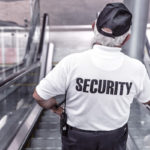Security Measures For Large Events
With the big game going down this Sunday, security for large-scale events is on our minds. Unfortunately, heavily publicized events that draw substantial attendance and large crowds tend to be prime targets for attacks and incidents. Luckily, proper security measures can prevent dangerous incidents from escalating further, or, ideally, from even happening at all. Here are a few things to keep in mind when it comes to event security.
- Security Posture
It is crucial to make security efforts visible. Bag checks, vehicle-free zones, and uniformed personnel make all the difference. - Constant Vigilance
Security personnel should be prepared to handle the crowd beforehand and screen every guest that enters, but security measures should remain in place throughout the entire event. It may be feasible to reduce some personnel when a majority of attendees have entered, however, no one should be able to enter the facility at any time without going through the same screening as everyone else. Once the event is underway, it makes it easier for potential attackers to move without being noticed. - Outdoor Security
If you uphold strong indoor security, an attacker may decide to carry out his actions outside. This makes it vital to maintain additional security measures around the perimeter and beyond (ex. mass transit connections, tailgate areas, merchandise locations). Typically, perpetrators will target large, dense gatherings of people. Spreading out locations to disperse crowds with ample security personnel makes it difficult for attackers to select a prime target. - Layers Of Security
As you may already tell, several layers of security are crucial. For example, your first layer of security may be traffic control personnel, who limit vehicle access to the venue and can watch for suspicious activity and individuals. Another layer may be personnel looking for potential criminal behavior in parking lots or directly outside the venue. Next would be the bag checks, magnetometers, and pat-downs to ensure prohibited items stay out of the venue. On the inside, you want to monitor the activities and prepare for the appropriate response, such as getting individuals to exits safely and getting emergency responders to the scene of an incident quickly. - Communication
Keep attendees informed about prohibited items and any other policies and rules before the event. These communications can be distributed with the help of ticketing outlets and public media. Getting this information out beforehand will help security lines and bag checks move smoothly and quickly, decreasing traffic and delays at the entrances. - Offsite Security Command Center
It makes sense to maintain a security command center onsite so that it is easy for people to find them if necessary. However, perpetrators know they can inflict more damage if they take down the command and communications center first. To combat this, while still maintaining an office within the venue, many facilities are moving the main command center offsite. By doing so, should an incident occur and the onsite center is compromised, security will still have eyes and means of communicating with the security personnel on site and still coordinate an appropriate response.
Tragic events over the years have forced us to reevaluate and tighten our security measures to keep the public safe. Now more than ever, security and emergency response personnel must work together to prevent and respond to major incidents. As an attendee, remember to be aware of your surroundings, and if you see something, say something.
For affordable, quality security systems, visit SecurityCamExpert.com or call 888-203-6294! We are happy to provide you with a free quote, schedule a site survey, or assist you with any questions you may have. You may also connect with us on Facebook, Google+, Twitter, LinkedIn, and Pinterest.
The Benefits Of Video Analytics
More and more surveillance camera systems are taking advantage of video analytics, which help to provide a better understanding of the areas being monitored. Whether they are added to your system via additional software or they are built-in to your security cameras, video analytics have advanced over time and deliver more practical and reliable performance.
Not only do video analytics improve overall security, but they can also provide valuable data for business intelligence. Here are some common and helpful video analytics functions and how they can benefit business.
- Facial Recognition
This function can identify individuals in real-time by cross referencing distinct characteristics against public and private databases and/or watch lists of known individuals. With that said, this function makes it easier to identify and locate wanted criminals if they are captured on smart cameras.
When it comes to casinos, for example, facial recognition can be used to detect cheaters. On the other hand, it can also be used to detect high rollers for VIP attention, or to detect high profile shoppers in a retail setting.
- Heat Mapping
Heat mapping measures and rates motion in a given image and uses color to portray the intensity of motion in that area. You might wonder how this data could help businesses, but there are numerous ways it does.
For example, retail stores can use heat mapping to better understand the flow of traffic. Knowing which way customers tend to travel when they enter the store (straight, left, right) can help business owners create a better floor plan. They can identify merchandising areas for optimal product placement which can then lead to increased sales. In addition, the data collected allows management to determine the high volume shopping days and times for more effective staffing and product placements.
- People Counting
This function is self explanatory, as it literally counts the number of people entering or exiting a specified area. This is especially useful for sports and entertainment venues as the data can help improve staffing for concession stands, ticketing areas, and entry/exit points. And since it is based on real-time data, security can better respond and allocate personnel when a large number of people quickly gather at an entrance. - Occupancy Estimation
Similar to people counting, occupancy estimation can determine on average how many people are present, even at different times of day. This data can benefit any type of venue or building. For example, event planners can optimize the use of space, improve staff planning, help determine business hours, and adjust lighting and temperature conditions accordingly. And in emergency situations, security can use this data to communicate with first responders to determine the best response. - Tripwire/Intrusion Detection
This acts as a virtual fence, which can detect when an object or person crosses the virtual line. When detected, security is alerted so they may assess the situation and address it right away. This can also reduce false alarms, and thus eliminate the added costs that go along with them. In warehousing and manufacturing environments, digital fencing can improve compliance by notifying personnel when people or materials cross designated work zone areas. - Motion Detection
Last but not least, motion detection has already proven extremely beneficial for security purposes. Nearly every security camera is equipped with motion detection, and with reason. This function allows you to designate an area of any shape or size, and when any motion is detected within this area, you will be alerted. Museums, for example, can benefit from this technology as it can be used to determine when people are getting too close to an exhibit, or when an object is picked up or moved.
Have you employed video analytics within your surveillance systems? Share your experiences with us on Facebook, Google+, Twitter, LinkedIn, and Pinterest.
For a grand selection of affordable, top quality security cameras and surveillance systems, please visit SecurityCamExpert.com. If you have any questions, would like to request a free quote, or want to schedule a site survey, please call us at 888-203-6294 and will be happy to help.
Surveillance Camera Features
Choosing the right video surveillance system can be tough. With various technologies to consider, as well as your own personal requirements, there’s a lot to consider. For your convenience, here are some common terms and technologies to help you choose the right video surveillance system for you.
Resolution
Because of our smart, HD televisions, we are all likely familiar with resolution as well as the units used to measure it (pixels). From its beginnings at 720 pixels to 1080p, we are now up to 4K and 5K resolution, with further advancements on the horizon.
The goal for resolution is to produce the clearest image for usability. This is defined by detection, recognition and identification and generally requires 80p around the face. Previously, pan, tilt, and zoom (PTZ) technology was employed to get a usable image. Now that camera resolution has greatly improved, less features and cameras are necessary to create high quality video surveillance.
Frame Rate
Another term you are likely familiar with is frame rate. The minimum requirement for the HDTV standard is 30 frames per second (fps). A higher frame rate is ideal, as it will produce a smooth, clearer video, however, it may not be practical. A higher frame rate also requires more bandwidth and storage space as these tend to be larger files. In this case, you should evaluate and prioritize your needs to determine the frame rate for you.
Networks & Storage
Security cameras are a small percentage of the overall cost of a surveillance system (the cost for cables and storage quickly accumulates). With that in mind, you should figure out what you intend to do with the footage so you can make the best decision for networks and storage. For example, ask yourself if you would like to store the footage for later review, actively monitor your feed, or would you like to do both.
Once you determine your goals and how long you need to retain footage (if at all), you can figure out how much space is necessary before your data gets overwritten. Depending on your system and needs, you may be able to refine these details per camera/location as necessary.
Video Compression
Since higher frame rates lead to larger files and more required storage, video compression technology works to counter that. As it advances, it promises to reduce bandwidth and storage to provide more affordable and convenient options for consumers. Currently, H.264 and H.265 are the standard, depending on the cameras you choose.
Light Sensitivity
As you may know, extreme light levels can interfere with a security camera’s ability to capture useful images. However, low light technologies have improved and can produce images in little to no light environments. For example, ‘lightfinder’ technology enables cameras to produce color video down to below one lux (one lux is a dark room, zero lux is an absence of light).
There’s also wide dynamic range, which allows cameras to capture usable images in varying lighting conditions. This feature adjusts and filters light to prevent washed out images, and is useful for hallways and doorways that can open into bright lights.
Software
While most systems come equipped with software (which should be updated and patched regularly and as necessary), you can find and install software applications that deliver specialized features and functions that you desire. Just remember that the higher the cost of the system means more features, which can translate into more training required to learn how to use it.
If you have any questions about security cameras or need help choosing surveillance systems and equipment, please feel free to contact us at 888-203-6294. You may also browse our stock online at SecurityCamExpert.com or connect with us on Facebook, Google+, Twitter, LinkedIn, and Pinterest.
Security Cameras Have Come A Long Way
It may be hard to believe, but the video camera has been around for more than 100 years (Fun fact: Thomas Edison helped develop it). A while after its inception, a handheld version was created, making cameras small enough to be out of sight. This technological advancement then spurred the beginning of video surveillance.
Before there were internet-connected cameras, there was Closed Circuit Television (CCTV). For a long time, CCTV was the security camera. CCTV security cameras were installed and directly connected to monitors. Then, you could either pay someone to monitor your camera feed or review recordings after the fact. Neither of these options was ideal – the former was costly, while the latter was not helpful in preventing incidents.
Luckily, improvements in technology have made it easier and more affordable to employ surveillance systems. We can now access live feeds from our security cameras remotely, which would not be possible without the advent of wireless security cameras and IP cameras. Here are some of the more prominent milestones of security cameras.
Streaming vs. Recording Cameras
As mentioned, most wireless security cameras these days are streaming live footage rather than using CCTV. It was about 20 years ago when IP cameras entered the market and changed the security industry. At this time, the video quality and technology were not yet up to par, but over time that changed. Continuing advancements brought forth IP cameras with high quality video along with the ability to stream online and control cameras remotely.
Hazard Detection
Video Content Analytics were first introduced about 10 years ago. The integration with security cameras enables multiple functions:
- Motion Detection: recognizes when a image changes as new subjects enter the field of view.
- Auto-Tracking: camera can follow a specific subject automatically.
- Smoke/Flame Detection: recognizes hazardous conditions related to fire to possibly prevent excessive damage.
- Tamper Recognition: camera offers real-time notification and works to suppress surrounding noises when tampering or disturbances are detected.
- Shape Recognition: allows face recognition to automatically identify people that enter the field of view.
Laser Focusing
One of the challenges with security cameras was poor footage with dark, unfocused recordings. Fortunately, laser focusing was introduced and provides better picture and recording in limited lighting environments. Security cameras that have laser focusing deliver improved zoom and picture quality as this feature enables nearly immediate focusing via laser. Infrared technology also improves visibility in dark conditions (much like night-vision goggles).
For a great selection of quality security cameras and surveillance systems, visit SecurityCamExpert.com or call 888-203-6294. You can also connect with us on Facebook, Google+, Twitter, LinkedIn, and Pinterest.
Smart Homes 2019: What To Expect
We have seen smart technology take over many aspects of our lives. From smart phones to smart watches, smart technology continues to improve our day to day living and is spreading to our homes. A smart home incorporates smart technology into your house for added convenience and security among other benefits. Find out how you can start turning your house into a smart home this year.
Lighting
This is the most common way that people ease into smart home technology. Smart lighting allows you to set a timer for your lights and control them through an app or possibly link them to your own voice assistant. But smart lighting is more than just convenience. Adjusting lighting when you are away from home helps to deter burglars by making it appear as if someone is home.
Cameras
Security cameras also act as a deterrent, ensuring that your property is monitored and informing potential trespassers that they are being watched and recorded. Should they proceed anyway, you are equipped with video evidence of the burglary.
Smart surveillance cameras, often equipped with high definition technology, can be installed anywhere in or around your home. When motion is detected, these security cameras can automatically begin recording and send you an alert via smart phone or device when this happens. Some smart cameras even employ facial recognition to inform you when certain people have arrived home or an unknown visitor is present.
Leak Detection
You also want to protect your home from damage, which is why smart leak detectors are growing in popularity. These alert you when water is detected where it shouldn’t be, preventing costly water damage and enabling you to address broken appliances or burst pipes immediately. Considering the cost of damages that you may be preventing, investing in these leak detectors is a smart choice.
Fridges
While not necessary, smart fridges offer a range of innovative and convenient features:
- Transparent doors to easily see what’s inside without opening the door
- Doors that open as you approach
- Frost-free smart drawers
- Interior cameras which can be viewed remotely so you can check inventory while you’re out
- Interactive touch screens for communicating, pinning notes, and even watching films
Doorbells
Much like a smart camera, a smart doorbell allows you to see who is at your door via your smart phone, with additional security features:
- Alerts when someone rings the doorbell
- View live footage from your front door
- Hear and speak to visitors
- Record video remotely to watch back as any time
- Motion sensor alerts when visitors don’t press the doorbell
Which smart home trends have you adopted already? Which smart home trends are you considering? Share with us on Facebook, Google+, Twitter, LinkedIn, and Pinterest.
For a wide array of security cameras and CCTV surveillance equipment, please visit us at SecurityCamExpert.com! To learn more about our installation services, or request a free quote, please call 888-203-6294.




